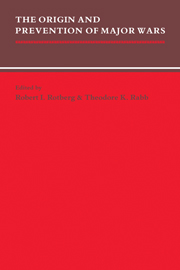Book contents
- Frontmatter
- Contents
- Introduction
- The Origins of War: Structural Theories
- The Origins of War: Explanation of Non-rational Causality
- Lessons and Analogies from Early Major Wars
- Lessons and Analogies from the World Wars
- The Origins of World War I
- Wargames: 1914–1919
- The Origins of World War II in Europe: British Deterrence Failure and German Expansionism
The Origins of the Pacific War
Published online by Cambridge University Press: 02 December 2009
- Frontmatter
- Contents
- Introduction
- The Origins of War: Structural Theories
- The Origins of War: Explanation of Non-rational Causality
- Lessons and Analogies from Early Major Wars
- Lessons and Analogies from the World Wars
- The Origins of World War I
- Wargames: 1914–1919
- The Origins of World War II in Europe: British Deterrence Failure and German Expansionism
Summary
“Whom the Gods would destroy they first make mad,” declared Congressman Hamilton Fish on December 8, 1941, the day after infamy. Minutes before, Franklin D. Roosevelt had asked Congress to declare war on the nation that had just launched the “unprovoked and dastardly” attack on Pearl Harbor, and Fish, an ardent isolationist, rose to support the president's request. “The Japanese,” he said, “have gone stark, raving mad, and have, by their unprovoked attack committed military, naval, and national suicide.”
Although others did not quote the classics, this madness theme was echoed throughout American newspapers that day: “sublime insanity” declared the New York Times; “the act of a mad dog” the Les Angeles Times announced; “an insane adventure that for fatalistic abandon is unsurpassed in the history of the world” argued the Philadelphia Inquirer. In December 1941, most observers agreed with Winston Churchill's statement that, since American military potential vastly outweighed Japan's, the Tokyo government's decision to go to war was “difficult to reconcile… with prudence, or even sanity.”
This belief that the Japanese must have been irrational to attack the United States continues to plague our understanding of the origins of the Pacific War and the lessons that modern strategists draw from that tragic occurrence. In the Pentagon, for example, the events of 1941 have inspired the dominant scenario for nuclear war: a lingering concern that can be described as hormephobia, the fear of shock or surprise, has haunted American strategic planning since Pearl Harbor.
- Type
- Chapter
- Information
- The Origin and Prevention of Major Wars , pp. 323 - 352Publisher: Cambridge University PressPrint publication year: 1989
- 7
- Cited by



